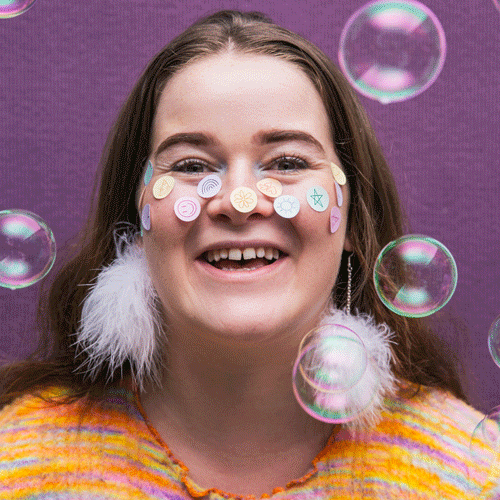In her ‘Accessibility 9 to 5’ series, Dayna Halliwell, junior strategist at Purple Goat, disabled and neurodivergent content creator and Sunflower Friend, shares her thoughts on the barriers and the unconscious bias she has faced in the workplace.
We all know that the working world can be challenging for many people but for individuals with hidden disabilities it can be even more difficult to navigate. Many are left wondering, how can I voice my needs in an environment that is inherently ableist and discriminatory? In this series of articles I have sought to answer that very question.
A bit about me:

My name is Dayna, I have several hidden disabilities and my working history is as diverse and colourful as a patchwork quilt. From working in retail to hospitality, education to marketing, I've had the opportunity to learn and grow in many different fields and as a result, have a wealth of experiences to share. In my time I have made mistakes, ignored my needs and faced my fair share of discrimination…
However, through these experiences, I have also gained a deeper understanding of how to navigate the working world as someone with hidden disabilities. I have learned to advocate for myself, to seek out resources and accommodations, and to communicate my needs in a way that feels authentic and empowering. And while I know that every person's journey is unique, I hope that by sharing snippets of my story, I can offer some insight and support to those who may be struggling to find their own voice in the workplace.
Story one - disclosing your disability is not always a safe option
My first job was as a waiter at a high-end restaurant in a posh Lancashire town. The workforce was made up of 16-18 year-olds in sleek black dresses and tights.
Excited to start my new job and earn money, I made sure to disclose my dyslexia to the manager. I explained it was a processing difficulty and I might take a little more time to get the hang of things but once I had, I would be flying.
This restaurant was a bit unusual in that it had three distinct divisions, each with its own menu: À la carte, Italian, and pub grub. It seemed like a random assortment of offerings, but that's what made the place unique. The catch was that all staff members had to work in all three sections simultaneously, which meant we had to keep track of a lot of different dishes unique to each section and table numbers.
Luckily for me, my mom had helped me draw up a colour coded cheat sheet with all the table numbers, which I kept tucked away in the front pouch of my apron. A few months had gone by, and I was starting to get the hang of things. I had become more familiar with the layout of the restaurant, and my cheat sheet of table numbers was becoming less of a crutch and more of a safety net.
The proof is in the table plan
One particularly busy Saturday shift, disaster struck. An English roast dinner meant for one table ended up at another - and not just any other table, but one in the Italian section of the restaurant. It was a cuisine nightmare, and the manager was absolutely livid. Anyone would have thought it was a cultural attack on Italy.
All the staff members were called to the kitchen for a lecture about the importance of getting orders right and the manager was determined to find the culprit to ‘teach them a lesson’. The manager scanned the room and soon her eyes set on me and one other girl, and through an accusatory tone she pointed at us in turn and said, "It's either the dyslexic girl or the new start" (pointing at ginger haired colour who flushed in panic)". Everyone else was dismissed and told to continue with their duties, while the two of us were pulled aside to be grilled by the manager one by one for a confession.
Many moments passed and neither of us admitted anything (spoiler alert: It wasn’t either of us). In sheer frustration the manager sat us down at a table surrounded by customers and instructed us to write out a full table plan. Her plan was that the person that was unable to achieve this would be identified as the person responsible for the mistake. For the next three hours, we sat there like children in the naughty corner, both struggling to write these numbers out for her because she was new and for me because I was dyslexic, all the while the manager passed between us eager for an end so she could deal out punishment. Unexpectedly, the owner's son came into the room and sheepishly admitted that it had in fact been his mistake…
Share without disclosing
This experience taught me a harsh reality: disclosing your disability is not always a safe option. However, there are alternative ways of letting people know without divulging specifics. That's where the Sunflower lanyard comes in. Many years later, in my next hospitality job I sought out a way to make sure I was never singled out for disclosing my hidden disability and that's when I discovered the Sunflower lanyard. It was great because it offered varying degrees of disclosure, so I could choose a format that suits me, I chose just the lanyard no card. This way, my colleagues and manager knew I had a disability, but they had no way of knowing what the specific disability was, meaning they couldn't use it against me. It also provided a constant visual cue, which was helpful in ensuring that I received extra time and patience.
The Sunflower in your 9-5
That brings us to the first tip of this series which is to incorporate the Sunflower symbol in your 9-5. If I had used the Sunflower in this context, my manager wouldn't have known specifics and thus, couldn't have jumped to conclusions.
Making the invisible visible isn't just a tool in being seen but a tool in being safe. If I had my time again in this sector I would've done it from the start. Here are my top products for working in hospitality:
Watch the video - TikTok - that was inspired by this event - click here.
To follow Dayna:







